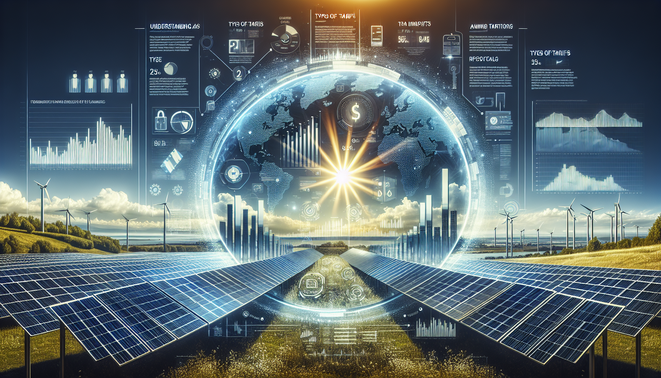Introduction to Solar Panel Tariffs
Solar panel tariffs, also known as import tariffs, are taxes imposed by governments on imported solar panels and associated equipment. These tariffs are crucial in shaping the renewable energy landscape, as they directly impact the cost and availability of solar energy products. When tariffs are imposed, the cost of imported solar panels rises, potentially leading to increased prices for consumers and slowing down the adoption of solar energy technologies. For more insights into solar energy costs and benefits, consider reading about the worth of solar power investments and how much solar panels really cost.
Types of Tariffs and Their Impacts
Tariffs play a significant role in shaping the economics of solar technology and manufacturing. Various types of tariffs have different implications for costs, and understanding them is essential for both consumers and businesses involved in solar energy.
- Import Tariffs: These are taxes levied on goods brought into a country. In the context of solar panels, import tariffs can significantly increase the costs of solar technology. For instance, the U.S. government has imposed tariffs on solar panel imports, which has led to an increase in prices for consumers and has potentially slowed growth in solar installations. The imposition of tariffs aims to protect domestic manufacturers, but it also raises the overall cost of solar projects and can deter investment in renewable energy sectors. [Source: Nasdaq]
- Export Tariffs: On the other hand, export tariffs are taxations on goods sent out of a country. For solar technology manufacturers, export tariffs can limit access to foreign markets, potentially stifling growth and innovation in the sector. If manufacturers face heavy export tariffs in other countries, their competitiveness is decreased, resulting in lost revenue opportunities.
- Subsidies and Government Incentives: Governments often implement subsidies and incentives to offset the costs associated with both the installation of solar technology and manufacturing. These can take various forms, such as tax rebates, feed-in tariffs, and direct grants. For example, the Investment Tax Credit (ITC) in the U.S. allows homeowners to deduct a significant percentage from their federal taxes for solar system installations. Such incentives help make solar technology more affordable and accessible, encouraging wider adoption. A comprehensive overview of these incentives can be found in this guide on solar power installation [Source: My Off Grid Home].
Conclusion on Tariff Impacts: The interplay between tariffs and governmental incentives creates a complex landscape for solar technology costs. While tariffs can raise costs for consumers, government subsidies can mitigate these impacts. It’s crucial for stakeholders to stay informed about policy changes that may affect pricing and the overall market landscape for solar technology. For further insights into the economic dynamics of solar power, refer to our article on whether solar power is worth the investment [Source: My Off Grid Home].

Regional Perspectives on Solar Tariffs
Regional perspectives on solar tariffs reveal an array of unique challenges and policies across North America, Europe, and Asia.
In North America, solar tariffs have been a contentious issue, particularly in the United States, where the federal government has imposed tariffs on imported solar panels to bolster domestic manufacturing. However, these tariffs have drawn criticism for potentially increasing costs for consumers and slowing the growth of the solar market. For instance, a study by the Solar Energy Industries Association estimates that the tariffs could lead to significant job losses in the solar installation sector as projects become more expensive [Source: SEIA].
In contrast, Europe has largely embraced renewable energy, with many nations implementing supportive policies and incentives for solar energy adoption. The European Union has set ambitious renewable energy targets, with regions like Germany leading the charge through its feed-in tariff system, which guarantees fixed payments for solar energy producers. This approach has significantly reduced the cost of solar installations and increased capacity, promoting a shift to sustainable energy sources [Source: Clean Energy Wire].
Asia, particularly China, dominates the global solar market through aggressive production and favorable government policies. The Chinese government has invested heavily in solar energy production and capacity expansion, resulting in lower prices for solar panels worldwide. However, this reliance has raised concerns over market monopolies and the long-term sustainability of solar manufacturing due to environmental impacts [Source: IEEE]. Additionally, countries like India are navigating challenges with solar tariffs, balancing the need to protect local manufacturers against encouraging international investment [Source: NITI Aayog].
Overall, solar tariff policies vary significantly across regions, influenced by unique economic conditions, government priorities, and market dynamics. As the global demand for sustainable energy continues to rise, these regional approaches to solar tariffs will remain pivotal in shaping the future of renewable energy. For more insights into solar energy investments and installation processes, check out our guides on solar power benefits and solar panel costs.
Future of Solar Panel Tariffs
Future projections for solar panel tariffs indicate a shifting landscape due to a combination of trade policies, market dynamics, and technological advancements. Analysts suggest that tariffs could fluctuate based on international trade relations and the pressure to protect domestic manufacturing. For instance, the Biden administration’s focus on clean energy could lead to either a relaxation of tariffs to encourage solar adoption or a restructuring aimed at balancing domestic interests with global competition.
Emerging innovations in solar technology, such as increased efficiency in photovoltaic cells and advancements in manufacturing techniques, may lessen the impact of tariffs. Hybrid solar systems, which integrate energy storage solutions, are also gaining traction, potentially diminishing reliance on imported solar panels. The U.S. Department of Energy is investing in research to improve the durability and efficiency of solar technologies, which could reshape cost structures in the near future [Source: EIA].
Moreover, as global supply chains adapt and new players enter the market, the competitiveness of domestic solar production is expected to rise, which might lead to a decrease in tariffs to stimulate growth and innovation in solar technology [Source: IREC]. Understanding these trends is essential for consumers and stakeholders in the solar industry who are navigating the evolving energy landscape [Source: My Off Grid Home].
Sources
- Clean Energy Wire – Regulations Supporting Solar Energy in Germany
- EIA – Energy Outlook Forecasts Increasing Solar Energy Input
- IEEE – Quality Criteria
- IEA – Renewables 2023
- IREC – What are the Impact of Tariffs on Solar Energy
- Nasdaq – How US Solar Tariffs Affect Renewable Energy Investments
- NITI Aayog – Indian Renewable Power 2022
- NREL – Solar Tariffs Analysis
- SEIA – Solar Tariff Lawsuits: Protecting Jobs and Environment
- SEIA – Solar Tariffs Impact
FAQs on Solar Panel Tariffs and Their Implications
Solar panel tariffs are taxes imposed on imported solar panels and components. These tariffs can increase the overall costs for consumers and companies in solar installation. They were primarily introduced to protect domestic manufacturers from foreign competition, particularly in the United States.
Higher tariffs on solar panel imports typically lead to increased costs for solar installations. As installation prices rise, the affordability of solar energy can decrease, potentially slowing the adoption of solar technology. According to the Solar Energy Industries Association (SEIA), these tariffs have led to an increase in costs from 10% to 30% depending on the product.
Regions heavily reliant on solar energy, such as California and Hawaii, feel the impact more significantly due to their extensive solar programs and commitments to renewable energy. The tariffs can lead to reduced capacity expansions and slower growth in solar installations in these areas, according to NREL’s analysis.
The future of solar tariffs is uncertain and often subject to change based on national trade policies and negotiations. Industry experts suggest that ongoing advocacy for trade relief may influence future tariff adjustments. Monitoring developments through resources like SEIA can provide insights on upcoming changes.
Homeowners should evaluate the total cost of installation, including potential tariffs, state incentives, and rebates. Understanding the local market dynamics and consulting with professionals can help to navigate the impacts of tariffs on overall project costs. For detailed guidance, check out our articles on solar investment and cost of solar panels.





